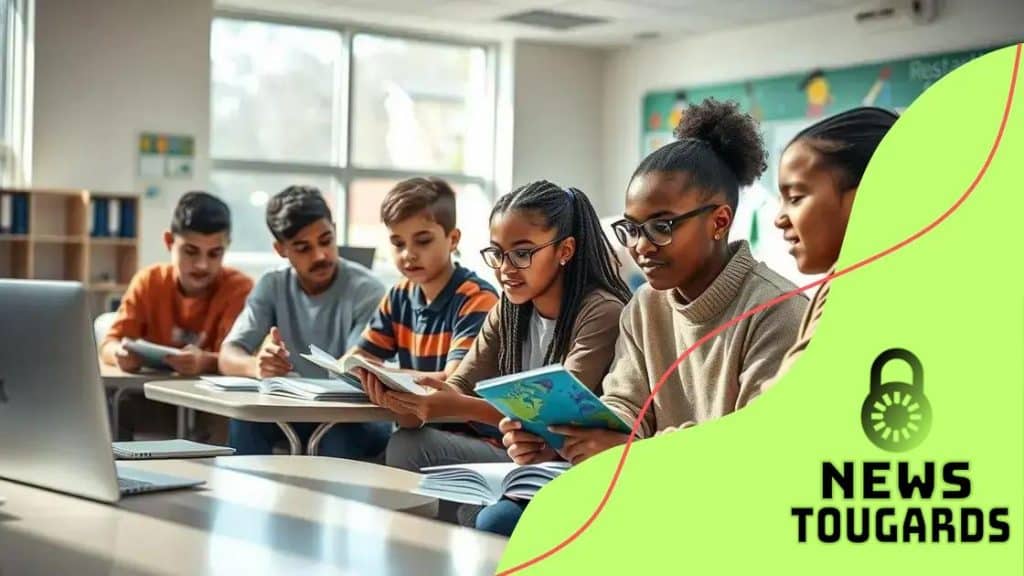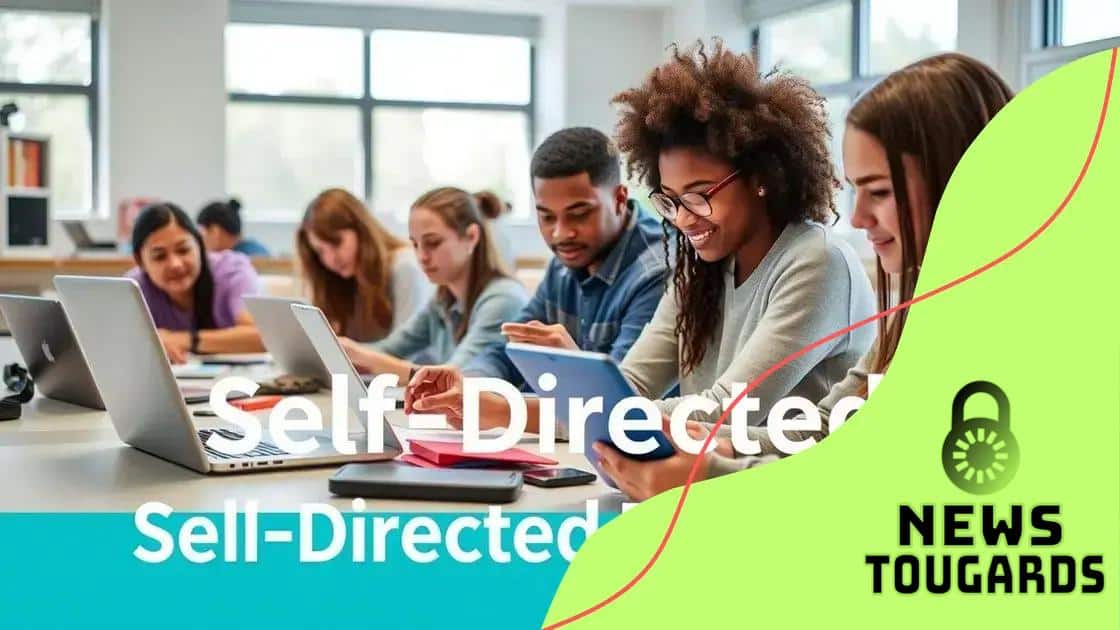The future of self-directed learning in higher education

The future of self-directed learning in higher education features increased technology integration, personalized learning experiences, and a focus on lifelong education, empowering students to take control of their learning journeys.
The future of self-directed learning in higher education is shaping the way students engage with their studies. Imagine a world where you control your learning trajectory. Let’s delve into this evolving landscape.
Understanding self-directed learning
Understanding self-directed learning is crucial in today’s education landscape. This learning approach allows students to take charge of their educational journey. They set their own goals, determine their learning paths, and assess their progress.
The core principles of self-directed learning
Self-directed learning revolves around a few key principles. First, students must be motivated and willing to learn. This intrinsic motivation drives them to seek out resources and knowledge independently. Additionally, they need the skills to manage their time effectively.
Key skills for success
Students can develop essential skills to thrive in a self-directed learning environment. Here are some important skills:
- Time management: Prioritizing tasks helps in balancing learning with other responsibilities.
- Research skills: Knowing how to find and evaluate resources is vital.
- Self-reflection: Regularly assessing one’s progress encourages growth.
- Goal setting: Clear, achievable goals provide direction.
Furthermore, self-directed learners often benefit from a supportive environment. Teachers play a significant role by offering guidance and resources. They can also create opportunities for students to engage with their peers. Collaboration and communication enhance the learning experience.
Challenges faced by learners
Despite its benefits, self-directed learning comes with challenges. Some students may struggle with organization and motivation. Others find it difficult to choose the right resources or may feel overwhelmed. Recognizing these challenges is essential for both learners and educators.
Surrounding oneself with a strong support system can help mitigate these issues. Additionally, institutions can provide workshops or resources to build essential skills. Embracing self-directed learning ultimately empowers students to become lifelong learners.
Benefits for students and institutions
Self-directed learning offers numerous benefits for students and institutions. This innovative approach not only empowers students but also enhances the overall educational experience.
Advantages for students
Students who engage in self-directed learning gain important skills that are valuable both academically and personally. They learn to take responsibility for their learning, which fosters a sense of ownership and motivation. This independence can lead to increased confidence and a greater willingness to explore new subjects.
- Enhanced critical thinking: Students develop the ability to analyze information and make informed decisions.
- Flexibility: They can learn at their own pace, accommodating different learning styles.
- Improved problem-solving skills: With self-direction, students learn how to tackle challenges creatively.
- Increased engagement: Taking charge of their learning can lead to a deeper connection with the material.
Moreover, this approach allows students to tailor their educational experiences to their interests and goals. It promotes a love for learning that goes beyond the classroom.
Advantages for institutions
For educational institutions, fostering a culture of self-directed learning can lead to significant benefits as well. Schools and universities can see improved student outcomes and higher satisfaction rates. When students are engaged and motivated, the overall learning environment becomes more dynamic.
Additionally, institutions can allocate resources more efficiently. Programs that promote self-directed learning often require less direct oversight from instructors, allowing educators to focus on supporting students when needed. This balance can lead to more innovative teaching methods and collaborative learning opportunities.
By embracing self-directed learning, institutions can better prepare students for future challenges in the workforce. Graduates who are independent learners are often more attractive to employers, as they possess essential skills that enhance workplace productivity.
Tech tools enhancing self-directed education

Technology plays a vital role in enhancing self-directed education. Today, students have access to a wide range of tools that make learning more engaging and effective. These tools help learners manage their time, find resources, and track their progress.
Popular tech tools for self-directed learners
Numerous platforms and applications support independent learning. These tools can cater to various learning styles, ensuring that every student can find what works best for them. Some noteworthy tools include:
- Learning management systems (LMS): Platforms like Moodle and Canvas allow users to access course materials, engage in discussions, and submit assignments remotely.
- Online courses: Websites such as Coursera and edX offer free and paid courses on a variety of subjects, enabling learners to pursue their interests.
- Productivity apps: Tools like Trello and Notion help students organize their tasks and manage their time efficiently.
- Video conferencing software: Zoom and Microsoft Teams enable real-time collaboration and communication among peers and educators.
In addition to these tools, there are many educational apps tailored for specific subjects. For instance, language learners can utilize apps like Duolingo, while students studying math can explore Khan Academy. These resources provide valuable content and interactive experiences that enhance understanding.
The impact of tech tools on learning
The incorporation of technology into self-directed education promotes flexibility and personalization. Students can choose when and how they study, accommodating their unique needs and schedules. This autonomy fosters a sense of responsibility and encourages lifelong learning.
Moreover, technology facilitates progress tracking and feedback. Learners can easily assess their performance through quizzes, assignments, and analytics. This data helps them identify areas for improvement and adjust their learning strategies accordingly. As students become more aware of their strengths and weaknesses, they can take control of their educational journeys.
Challenges in self-directed learning
While self-directed learning has many advantages, it also comes with several challenges that can impact students’ success. Understanding these obstacles can help learners and educators develop strategies to overcome them.
Lack of motivation
One common challenge students face is a lack of motivation. Without a structured environment, some learners may struggle to engage with their studies. This can lead to procrastination and lower academic performance. Overcoming this challenge often requires self-discipline and a clear understanding of personal goals.
Resource management
Another challenge is effectively managing resources. Self-directed learners need to know how to find credible information and tools to support their education. Sometimes, students may feel overwhelmed by the sheer amount of content available online. To tackle this, it’s essential to cultivate effective research skills and discern credible sources.
Time management difficulties
Time management is crucial in a self-directed learning setting. Students may find it tricky to balance their studies with other commitments, such as work or family responsibilities. Developing a structured schedule can help students allocate time for learning while ensuring they fulfill other obligations. Setting specific goals and deadlines can also aid in maintaining focus and accountability.
Isolation and support
Additionally, a sense of isolation can be a significant concern. In traditional settings, students often benefit from social interactions and support from their peers and instructors. When learning independently, students might feel disconnected and miss the collaborative elements of education. Engaging with online forums or study groups can help alleviate feelings of isolation and promote community.
Being aware of these challenges allows students to develop strategies to navigate them. By building good study habits, utilizing available resources effectively, and seeking support from others, learners can enhance their self-directed educational experiences.
Future trends and predictions
The future trends and predictions in self-directed learning show promising advancements. As education continues to evolve, several key trends are emerging that will shape how students learn independently.
Increased use of technology
Technology will play a significant role in enhancing self-directed learning. With the rise of artificial intelligence and machine learning, personalized learning experiences will become more prevalent. Students will benefit from tailored educational content that meets their specific learning needs and preferences.
More collaborative learning environments
Another trend is the growth of collaborative learning platforms. As students increasingly seek social interaction, virtual study groups and peer-to-peer learning will rise. These platforms not only offer support but also create a sense of community among learners.
Focus on lifelong learning
As the job market continues to change, there is a growing emphasis on lifelong learning. Self-directed learners will need to cultivate skills that allow them to adapt to new challenges over their careers. This pursuit of knowledge will encourage continuous personal and professional development.
Integration of soft skills training
Moreover, soft skills training will be more integrated into self-directed learning programs. Skills such as critical thinking, communication, and problem-solving will be essential for success. Educators will focus on providing resources that help students develop these vital skills alongside their academic knowledge.
As we look to the future, it’s clear that self-directed learning will continue to evolve. By leveraging technology, fostering collaboration, and emphasizing lifelong education, students will be better equipped to navigate the complexities of modern life.
FAQ – Frequently Asked Questions about the Future of Self-Directed Learning
What are the main advantages of self-directed learning?
Self-directed learning allows students to take control of their education, fostering independence, critical thinking, and personalized learning experiences.
How can technology enhance self-directed learning?
Technology provides tools that facilitate personalized learning, collaboration, and resource management, helping students engage more effectively in their studies.
What challenges do students face in self-directed learning?
Students often struggle with motivation, time management, and resource management, and they may feel isolated without peer support.
What trends are shaping the future of self-directed learning?
Future trends include increased technology integration, a focus on lifelong learning, more collaborative environments, and greater emphasis on developing soft skills.





